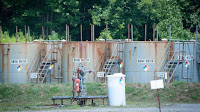We’re living beyond our means when it comes to groundwater. That’s probably not news to everyone, but new research suggests that, deep underground in a number of key aquifers in some parts of the United States, we may have much less water than previously thought.
“We found that the average depth of water resources across the country was about half of what people had previously estimated,” says Jennifer McIntosh, a distinguished scholar and professor of hydrology and atmospheric sciences at the University of Arizona.
McIntosh and her colleagues — who published a new study about these aquifers in November in Environmental Research Letters — took a different approach to assessing groundwater than other research, which has used satellites to measure changes in groundwater storage. For example, a 2015 study looked at 37 major aquifers across the world and found some were being depleted faster than they were being replenished, including in California’s agriculturally intensive Central Valley.
McIntosh says those previous studies revealed a lot about how we’re depleting water resources from the top down through extraction, such as pumping for agriculture and water supplies, especially in places like California.
But McIntosh and three other researchers wanted to look at groundwater from a different perspective: They examined how we’re using water resources from the bottom up.
The study may help close the gap about what we know and don’t know regarding how much water is available deep underground, as well as its quality.
It also rings some alarm bells.
A Different Approach
Instead of examining how fast water tables were falling, as in previous studies, the researchers looked at water chemistry to determine how deep underground you could drill for freshwater or brackish water before that water became too salty to use.
...
The researchers used information from the U.S. Geological Survey on the quality of groundwater across the country and looked specifically at salinity — how salty the water is. “We looked basin by basin at how that depth of fresh and brackish water changes across the United States,” says McIntosh.
The results were about half as much usable water as previous estimates. That means that deep groundwater reserves are not nearly as plentiful as we’d thought in some places.
That’s important because when shallow groundwater reserves become depleted or polluted, the strategy so far has been to drill deeper and deeper wells to keep the water flowing.
But we may not always be able to drill our way out of water shortages. “Tapping into these deep waters works for now, but the long-term prospects for using these waters are quite concerning,” says the report’s lead author, Grant Ferguson, an associate professor in the department of Civil and Geological Engineering at the University of Saskatchewan.
Read much more at Warning: A ‘Shrinking Window’ of Usable Groundwater — and the Oil and Gas Industry Isn't Helping

No comments:
Post a Comment